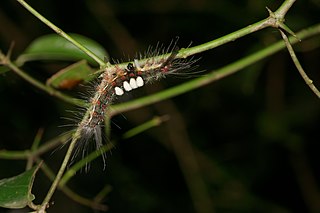
The Pterophoridae or plume moths are a family of Lepidoptera with unusually modified wings. Though they belong to the Apoditrysia like the larger moths and the butterflies, unlike these they are tiny and were formerly included among the assemblage called "microlepidoptera".

The Tortricidae are a family of moths, commonly known as tortrix moths or leafroller moths, in the order Lepidoptera. This large family has over 10,350 species described, and is the sole member of the superfamily Tortricoidea, although the genus Heliocosma is sometimes placed within this superfamily. Many of these are economically important pests. Olethreutidae is a junior synonym. The typical resting posture is with the wings folded back, producing a rather rounded profile.

The superfamily Papilionoidea contains all the butterflies except for the moth-like Hedyloidea.

Oecophoridae is a family of small moths in the superfamily Gelechioidea. The phylogeny and systematics of gelechoid moths are still not fully resolved, and the circumscription of the Oecophoridae is strongly affected by this.

The Elachistidae are a family of small moths in the superfamily Gelechioidea. Some authors lump about 3,300 species in eight subfamilies here, but this arrangement almost certainly results in a massively paraphyletic and completely unnatural assemblage, united merely by symplesiomorphies retained from the first gelechioid moths.
Dudgeonea is a small genus of moths and the only genus of its family, the Dudgeoneidae. It includes six species distributed sparsely across the Old World from Africa and Madagascar to Australia and New Guinea.

The Lymantriinae are a subfamily of moths of the family Erebidae.

Drain flies, sink flies, filter flies, or sewer gnats (Psychodidae) are small true flies (Diptera) with short, hairy bodies and wings giving them a "furry" moth-like appearance, hence one of their common names, moth flies. There are more than 2600 described species worldwide, most of them native to the humid tropics. This makes them one of the most diverse families of their order. Drain flies sometimes inhabit plumbing drains and sewage systems, where they are harmless, but cause persistent annoyance.

The Dalceridae are a small family of zygaenoid moths with some 80 known species encompassing about one dozen genera mostly found in the Neotropical region with a few reaching the far south of the Nearctic region.

Gracillariidae is an important family of insects in the order Lepidoptera and the principal family of leaf miners that includes several economic, horticultural or recently invasive pest species such as the horse-chestnut leaf miner, Cameraria ohridella.
The small Lepidopteran family Douglasiidae includes several species of moths whose adults are collectively called Douglas moths and whose larvae are leaf miners. The largest genus in the family is Tinagma.

Choreutidae, or metalmark moths, are a family of insects in the lepidopteran order whose relationships have been long disputed. It was placed previously in the superfamily Yponomeutoidea in family Glyphipterigidae and in superfamily Sesioidea. It is now considered to represent its own superfamily. The relationship of the family to the other lineages in the group "Apoditrysia" need a new assessment, especially with new molecular data.

Schinia, commonly called flower moths, is a large genus of moths belonging to the family Noctuidae. The genus has a Holarctic distribution with the vast majority of species being found in North America, many with a very restricted range and larval food plant.
Agathiphaga is a genus of moths in the family Agathiphagidae, known as kauri moths. This caddis fly-like lineage of primitive moths was first reported by Lionel Jack Dumbleton in 1952, as a new genus of Micropterigidae.
Andesiana is a genus representing its own family Andesianidae and superfamily Andesianoidea, the "Andean endemic moths". It contains three species with a wingspan up to 5.4 cm. in female A. similis and 3.5 cm. in males. This far surpasses in size any previously known monotrysian moth. These large Microlepidoptera are restricted to Andean South America, from where they were described originally in 1989 in the family Cossidae by their discoverer Patricia Gentili.

Olethreutinae is a subfamily of moth in the family Tortricidae.

Victrix is a genus of moths in the family Noctuidae described by Otto Staudinger in 1879. It may be synonymous with the genus Moureia.
Cryphia petrea is a moth of the family Noctuidae. It is found from Spain through North Africa to the Near East and Middle East. In the Levant it is found in Lebanon, Jordan and Israel.

Scythris is a genus of gelechioid moths. It is the type genus of the flower moth family, which is sometimes included as a subfamily in the Xyloryctidae, or together with these merged into the Oecophoridae. The genus was erected by Jacob Hübner in 1825.
Pterophorinae is a subfamily of moth in the family Pterophoridae.















